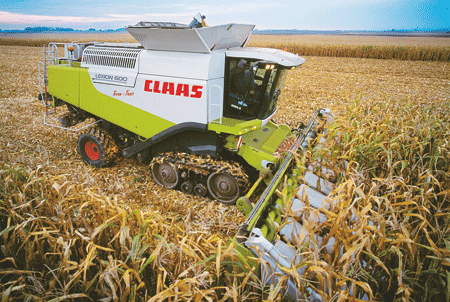Shropshire contractor replaces beet with maize

Until a couple of years ago, the growing and harvesting of 1000ha (2500 acres) of sugar beet formed the backbone of Steve Banks’ contracting business.
It provided work throughout the winter months and provided a useful income for the business.
But British Sugar’s decision to close its Allscot sugar factory in 2006 changed all that and left Mr Banks with a few serious decisions to make.
Based at Cherrington, near Newport, Shropshire, Mr Banks was left with a shed full of beet planting and harvesting machinery. This included a six-row self-propelled Vervaet beet harvester which he had purchased new for £250,000 only two years before and a pair of trailed Thyregod three-row harvesters.
“You have to remember that sugar beet was an important crop in this area,” he says. “For my business it not only provided an income but it also meant that my staff were fully employed at a time of the year when we could have been looking for something to do.”
Clearly, the demise of the sugar beet business called for a rethink and Mr Banks decided to offer a grain maize service to growers.
“There was a reasonably high interest from arable farmers looking to grow a crop that could provide a replacement for the sugar beet crop,” he says. “And there are quite a few livestock farmers who recognise the value of grain maize.

Harvesting grain maize. Steve Banks uses an 8-row Cressoni header with his Claas Lexion 450 combine.
“On the plus side, we would also be getting more use out of our Claas Lexion combine harvester rather than seeing it parked under the barn.”
He makes the point that with the drilling of maize taking place in March and harvest commencing in late September or early October, the job would go some way to filling the gap left by the demise of the sugar beet.
It is one thing to make the decision to start a grain maize growing service but quite another to get geared up for it, however.
“We had to buy an eight-row Cressoni maize header for the combine which cost about £40,000 and then there was the new drill and the Kelvin Cave crimper we needed. It all came to over £100,000,” he says. No mean investment for any project.
Last March Mr Banks made a start drilling 180ha (450 acres) of maize using a drill that applied a pre-emergent spray and covered the ground with plastic.
With the maize in the ground and growing, Mr Banks could concentrate on the other services his contracting business offers – cereal drilling, spraying, forage harvesting, muck spreading and, of course, combine harvesting.
The harvest of the maize started in early October and Mr Banks concedes that he was perhaps a little too early.
“I think we were all a little apprehensive about the job and anxious to see how the combine and the header would work,” he says. “I think, with hindsight, we should have held off for another couple of weeks – but who is to say what the weather is going to do at that time of the year?”
But it was not just the harvesting of the crop which needed to be tested, there was also the crimping and application of an organic acid-type preservative.
And just to complicate things even further, because the maize was being harvested and crimped on an arable farm, it had to be transported almost immediately to the purchasing stock farm for ensiling where, if there was not sufficient clamp space, a contractor with a “sausage” filling system had to be present.
The Lexion, with its 8-row header, managed an output of about 4ha/hour (10 acres) which, with a yield of just over 11 t/ha meant that the Kelvin Cave 2000 crimper was not over-taxed to keep up with incoming maize.
“Overall, I think we’ve made a steady start and learnt a lot about grain maize growing,” he says. “This coming year I would hope to expand the acreage to over 800 which will be a useful area to handle – but it still has some way to go before it replaces sugar beet.”
